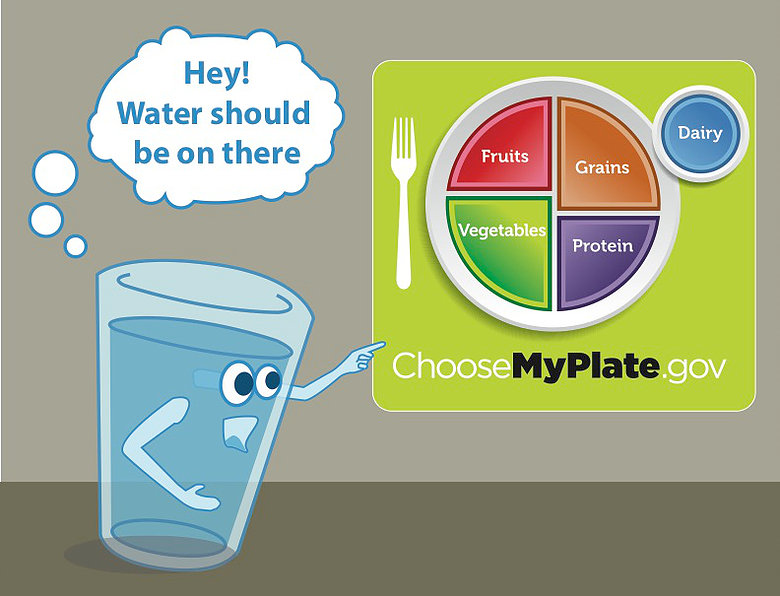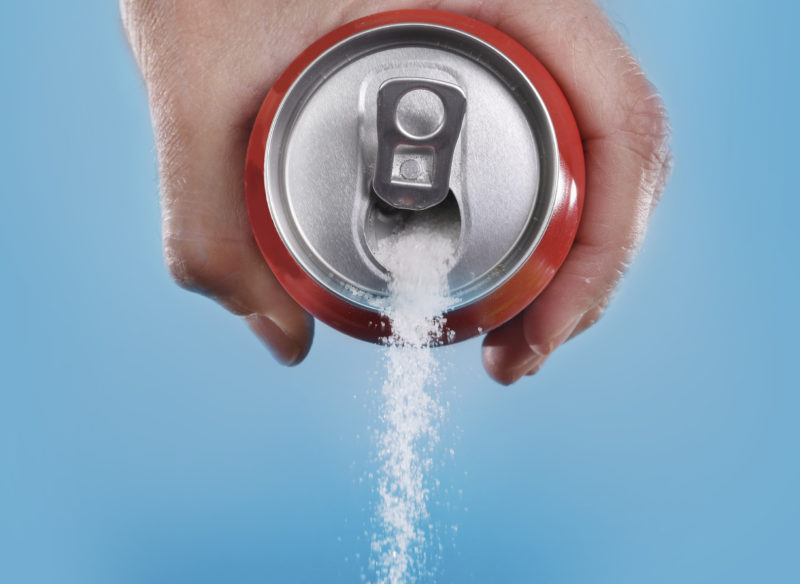
Share On Social!
Amid an obesity crisis and a coronavirus pandemic, Latinos and all people need more water, and less sugar.
Do you agree?
Speak up! Submit a model comment below to urge the 2020-2025 Dietary Guidelines for Americans to add water to the MyPlate/MiPlato graphic, reduce the amount of added sugars, and make healthier diets equitable for all people!
Update 6/11/20: Over 55,000 people submitted comments!
Submit a Comment for Dietary Equity!
 Nearly two of every three people in the United States live with at least one chronic disease like obesity and heart disease, according to the CDC. These are caused in part by poor diets. Unhealthy eating is now the top cause of premature death in the nation (https://salud.to/unhealthy-eating-death). Communities of color and low-income families are disproportionately impacted by nutrition-related diseases. Latinos, for example, tend to live in food swamps with an abundance of unhealthy fast food options and a void of grocery stores and farmer’s markets with healthier options, according to a Salud America! research review (https://salud.to/foodres). This leads to over-consumption of unhealthy food and higher rates of obesity among Latino children (https://salud.to/childobesity) and Latino adults (https://salud.to/2m4qk0x). Achieving health equity through the Dietary Guidelines for Americans—the leading set of nutrition recommendations for people and public health professionals—is paramount. We must bring healthier diets within reach of all populations. As suggested by the Union of Concerned Scientists, I urge USDA and HHS to draft and publish Dietary Guidelines for Americans that are consistent with current science, prioritize our most vulnerable populations, and identify complementary programs and policies to support healthy food access and address the root causes of health disparities.
Nearly two of every three people in the United States live with at least one chronic disease like obesity and heart disease, according to the CDC. These are caused in part by poor diets. Unhealthy eating is now the top cause of premature death in the nation (https://salud.to/unhealthy-eating-death). Communities of color and low-income families are disproportionately impacted by nutrition-related diseases. Latinos, for example, tend to live in food swamps with an abundance of unhealthy fast food options and a void of grocery stores and farmer’s markets with healthier options, according to a Salud America! research review (https://salud.to/foodres). This leads to over-consumption of unhealthy food and higher rates of obesity among Latino children (https://salud.to/childobesity) and Latino adults (https://salud.to/2m4qk0x). Achieving health equity through the Dietary Guidelines for Americans—the leading set of nutrition recommendations for people and public health professionals—is paramount. We must bring healthier diets within reach of all populations. As suggested by the Union of Concerned Scientists, I urge USDA and HHS to draft and publish Dietary Guidelines for Americans that are consistent with current science, prioritize our most vulnerable populations, and identify complementary programs and policies to support healthy food access and address the root causes of health disparities.
Go here to tweak and submit this comment:
Submit a Comment to Add Water to My Plate / Mi Plato!
The MyPlate graphic is a good reminder of the five food groups for good nutrition. However, to make it better, the National Drinking Water Alliance has launched a campaign to add a water symbol to the graphic.
You can speak up for this action using and tweaking this comment:
 Consuming water daily is optimal for health. However, Latino kids at all ages consume less water and more sugary drinks—soda, sports and energy drinks, sugary fruit juices, and flavored milk—than the average child. This extra consumption puts them at greater risk of unhealthy weight, according to a Salud America! research review (http://salud.to/sugarresearch). The MyPlate graphic (MiPlato in Spanish) is the current nutrition guide published by the USDA Center for Nutrition Policy and Promotion, based on the recommendations of the Dietary Guidelines for Americans. MyPlate is often shown to children to cultivate a healthy eating style that will build throughout a lifetime. However, the MyPlate/MiPlato graphic lacks water. As suggested by the National Drinking Water Alliance, I urge USDA and HHS to add strong language about drinking water in the 2020-2025 Dietary Guidelines and add a symbol for water on the MyPlate/MiPlato graphics. Adding drinking water to this valuable tool would improve American’s nutrition.
Consuming water daily is optimal for health. However, Latino kids at all ages consume less water and more sugary drinks—soda, sports and energy drinks, sugary fruit juices, and flavored milk—than the average child. This extra consumption puts them at greater risk of unhealthy weight, according to a Salud America! research review (http://salud.to/sugarresearch). The MyPlate graphic (MiPlato in Spanish) is the current nutrition guide published by the USDA Center for Nutrition Policy and Promotion, based on the recommendations of the Dietary Guidelines for Americans. MyPlate is often shown to children to cultivate a healthy eating style that will build throughout a lifetime. However, the MyPlate/MiPlato graphic lacks water. As suggested by the National Drinking Water Alliance, I urge USDA and HHS to add strong language about drinking water in the 2020-2025 Dietary Guidelines and add a symbol for water on the MyPlate/MiPlato graphics. Adding drinking water to this valuable tool would improve American’s nutrition.
Go here to tweak and submit this comment:
Submit a Comment to Reduce Added Sugars!
 Added sugars are contributing to an obesity crisis among our youngest children. More than four in 10 (45%) white children have had a sugary drink by age 2 and nearly three in four (74%) Latino children have, according to a Salud America! research review (http://salud.to/sugarresearch). Additionally, nearly 60% of infant and toddler food and drink advertising dollars promoted products that are not recommended for young children, including sugar-sweetened toddler milk (https://salud.to/babyfoodmarket). Nearly 2 of 3 U.S. children’s drinks sold in 2018 were unhealthy fruit drinks and flavored waters with added sugars and/or diet sweeteners (https://salud.to/childrens-drinks). The Union of Concerned Scientists suggest that, even though the 2015-2020 Dietary Guidelines for Americans recommended that added sugars should be limited to 10% of a person’s daily calories, the science suggests this threshold should be lower (no more than 6%). They also suggest developing age-appropriate added sugar limits for children, including science-based recommendations of no added sugar for children younger than 2. I urge USDA and HHS to publish Dietary Guidelines for Americans that are consistent with current science about no added sugars for children younger than 2, and a lower recommended limit of added sugars among a person’s daily calories.
Added sugars are contributing to an obesity crisis among our youngest children. More than four in 10 (45%) white children have had a sugary drink by age 2 and nearly three in four (74%) Latino children have, according to a Salud America! research review (http://salud.to/sugarresearch). Additionally, nearly 60% of infant and toddler food and drink advertising dollars promoted products that are not recommended for young children, including sugar-sweetened toddler milk (https://salud.to/babyfoodmarket). Nearly 2 of 3 U.S. children’s drinks sold in 2018 were unhealthy fruit drinks and flavored waters with added sugars and/or diet sweeteners (https://salud.to/childrens-drinks). The Union of Concerned Scientists suggest that, even though the 2015-2020 Dietary Guidelines for Americans recommended that added sugars should be limited to 10% of a person’s daily calories, the science suggests this threshold should be lower (no more than 6%). They also suggest developing age-appropriate added sugar limits for children, including science-based recommendations of no added sugar for children younger than 2. I urge USDA and HHS to publish Dietary Guidelines for Americans that are consistent with current science about no added sugars for children younger than 2, and a lower recommended limit of added sugars among a person’s daily calories.
Go here to tweak and submit this comment:
Why Comment on the Dietary Guidelines?
The government updates the guidelines every five years. They help people choose an overall healthy diet.
Guidelines set nutritional targets and dietary limits for children (ages 2-18), adults (19-64), and older adults (65 and older). Now, for the first time, guidelines will cover pregnant women and babies (birth to age 2).
Currently, the Dietary Guidelines Advisory Committee will spend the next year reviewing nutrition science. They will present findings in spring 2020 to the U.S. Department of Agriculture (USDA) and Department of Health and Human Services (HHS). USDA and HHS will issue final guidelines by December 2020.
Your comments can help the committee in their work.
Comment by June 1, 2020!
By The Numbers
142
Percent
Expected rise in Latino cancer cases in coming years



